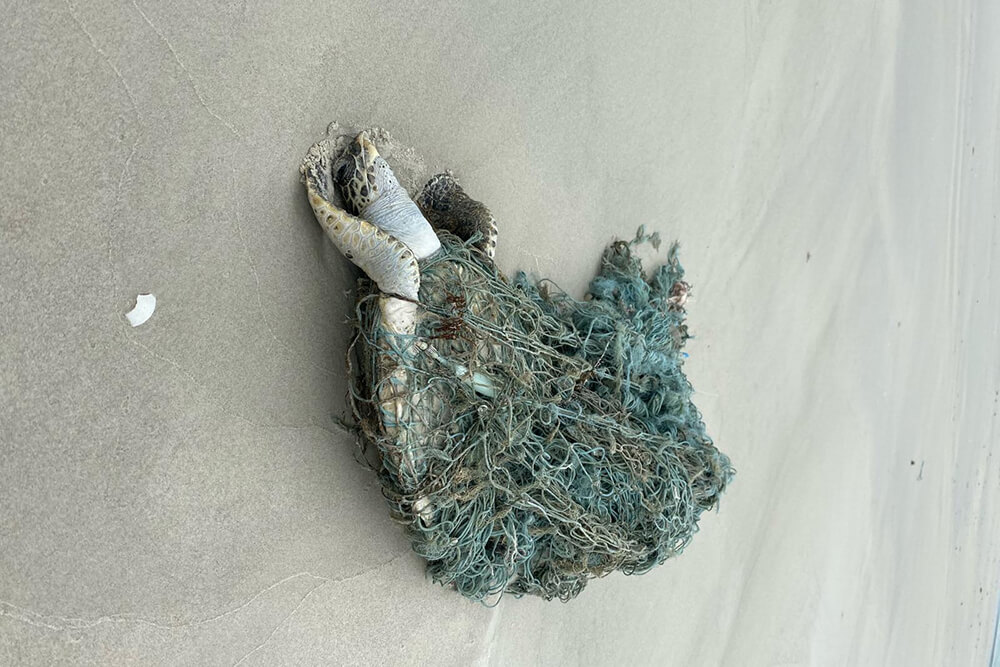The Indigenous Ranger Coastal Clean-up Project was established to tackle the significant impact ghost nets are having across the Gulf of Carpentaria.
The project put leading edge technology (drones, state-of-the art mapping and artificial intelligence AI) in the hands of Traditional Owners, combining Indigenous knowledge with modern science to restore and protect Sea Country.
Funded by Parks Australia, it was delivered in collaboration with the department and 24 Indigenous ranger groups.
Ghost nets
Ghost nets are abandoned or lost fishing nets that drift with the currents, entangling marine life and pollute Australia’s pristine northern coastline.
They cause significant environmental damage, introduce marine pests that are a biosecurity risk to our native species, synthetic materials and create safety hazards impacting shipping or navigation.
Ghost nets can be kilometres long and weigh up to several tonnes.
![Removing a ghost net [copyright Timothy Hillier]](/sites/default/files/images/removing-a-ghost-net.jpg)

The Gulf of Carpentaria
Due to the unique clockwise current pattern known as gyre, the Gulf of Carpentaria is one of the world’s most severe hotspots for ghost nets and marine debris.
The project snapshot
Funding: 2.8 million
Timeline: 2021 – 2025
Area of coastline: 1,725 kilometres throughout the Gulf of Carpentaria and the northern coast of Australia.
Technology used: Aerial platforms - drones and their associated mapping capabilities and helicopters.
- The use of drones and their artificial intelligence (AI) capabilities to design area-specific monitoring programmes led by Traditional Owners, is a world first.
- Previously, monitoring methods could be time-consuming and limited in scope.
- Now, using AI and Traditional Knowledge, rangers can analyse the collected images in vast and remote marine environments.
- Data collected by combining the use of drones and helicopters, is processed by AI to detect and calculate debris concentrations and net locations.
- Traditional Knowledge offers deep insights into local ecosystems, seasonal patterns, and culturally significant sites. This cutting-edge tech approach respects Indigenous culture and supports their role in caring for coastal and marine environments in a sustainable manner.
- Using this innovative technology in this way assists rangers to make operational decisions unique to their organisations on where to allocate resources, funding and monitoring for future management. Rangers can now cover hundreds of kilometres of remote coastline faster and more effectively.
The results
- 900 ghost nets removed
- 190,000, kilograms of marine debris cleared
- 1,725 kilometres of coastline surveyed
- Of the rubbish removed 77.5% was plastic. The remainder comprised foam, rubber, glass, metal, wood and other materials.
The efforts of the Indigenous rangers have saved marine life, protected cultural heritage, and strengthened communities along northern Australia’s shores.
Next steps
This project will continue under Parks Australia’s leadership, in partnership with Indigenous rangers evolving into an expanded, sustainable coastal protection program.
The Arafura and Timor Seas Ecosystem Action Program (ATSEA)
Rangers involved in the project are now working with neighbouring nations to help stop ghost nets at the source.
This is the first time Traditional Owners have led cross-border discussions on managing ghost nets and marine debris.
The project demonstrates how community-led solutions can influence global change.
The videos below share the story of the project - highlighting the determination, knowledge and achievements of the Indigenous rangers.
Sea Country, Strong Country
If you have difficulty accessing this file, contact us for help.
Yes, hello Bukmak, my name is Mungul. Marcus is my English name.
Representing Gumurr Marthakal Rangers from Echo Island.
We’re here with all the other rangers, from around this area, Arnhem Land, but also the other side of Queensland and Western Australia.
We’re just standing here, trying to figure out how to get rid of this.
It’s a big day, the impact of this type of debris, this is the major one, this is the one that causes all the headaches – it impacts everyone.
Basically, not only in Australia, or in our beautiful part of the area, but the whole world needs to do something about this. I hope this message gets out, to everybody who is watching and we have learned, that it’s not only our problem, it’s everybody’s problem.
So, we need to come up with a solution. The whole world needs to wake up.
In northern Australia, rangers face some of the most remote and logistically challenging conditions on Earth, yet have some of the highest concentrations of ghost nets and marine debris.
The Indigenous Ranger Coastal Cleanup Project is a partnership between the Australian Government's Parks Australia, the Department of Agriculture, Fisheries and Forestry's Indigenous Ranger Biosecurity Program, and our First Nations communities.
The IRCCP is guided by knowledge shared by Traditional Owners and Indigenous Rangers leading every step of the way.
Culture shapes the strategy, connection to country shapes the care.
The best thing about, bringing people to this location is to illustrate the degree of difficulty because this is not pull up with trucks and pull up with machines and like this is hand done, this is serious labour, difficult access, and there's no better way for all of us who have come along today to take away with us, this story, this reality, because we've had our hands in it, and,
Realize that, it's this much, but we can tell the story this big, and that's the most important thing that I, I think this activity, you see all these 4 wheel drives, it's like, this is, this ain't normal. This is not normal.
Related
To learn more about the work of Indigenous rangers in biosecurity, subscribe to the Frontline Ranger Newsletter.
